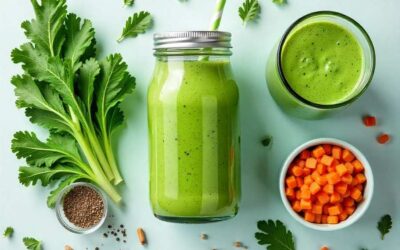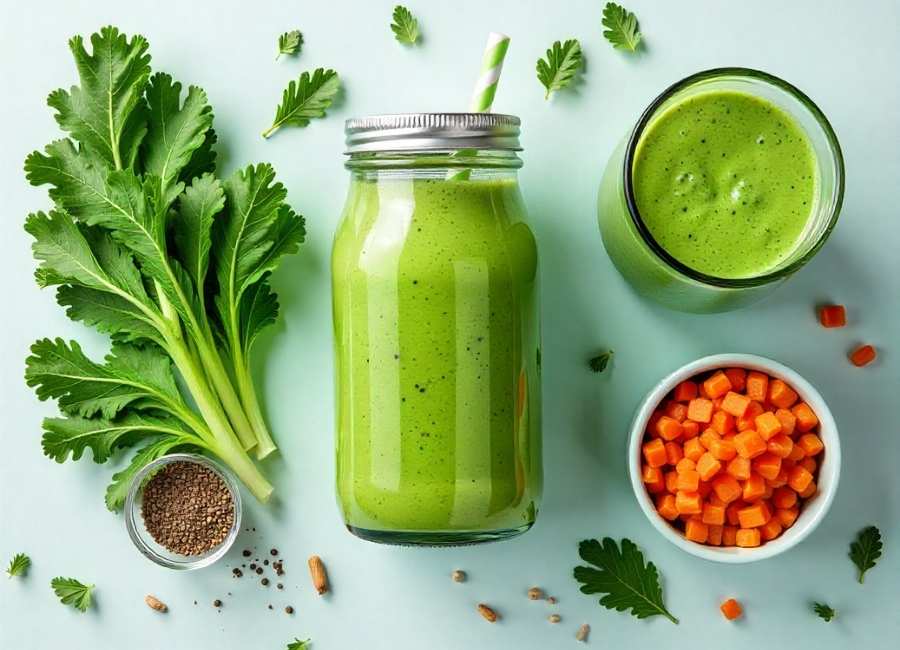Not long ago, kale was just a garnish on salad bars. Today, it’s a superfood found in everything from smoothies to snacks. This leafy green is popular for good reason: it’s full of nutrients, versatile, and easy to add to your meals.
This guide covers everything you need to know about kale. We’ll look at its nutrition, health benefits, and the best ways to cook it. Whether you love kale or are just curious, you’ll find tips on how to choose, store, and prepare this healthy vegetable.
What is Kale?

Kale belongs to the cruciferous vegetable family, along with broccoli, cauliflower, cabbage, and Brussels sprouts. (Produce 101: Cruciferous Vegetables, n.d.) It has an earthy, slightly bitter taste and sturdy leaves, and people have grown it for thousands of years. (Kale – Wikipedia, n.d.) Kale grows best in cool weather and can taste sweeter after a light frost.
There are several popular types of kale, each with its own texture and flavor:
- Curly Kale: This is the most common type you’ll find in grocery stores. It has ruffled, bright green leaves and a pungent, peppery flavor.
- Lacinato Kale (Dinosaur or Tuscan Kale): This variety features long, bumpy, dark green leaves. It has a slightly sweeter, more delicate taste than curly kale and a firmer texture.
- Red Russian Kale: With flat, fringed leaves and distinctive purplish-red stems, this type is sweeter and more tender than other varieties, making it great for salads.
Kale’s Nutritional Powerhouse
Kale has earned its “superfood” status due to its dense nutritional content. (Kale: Discover Superfood Secrets, 2023) It’s low in calories but high in essential vitamins and minerals, making it one of the most nutrient-dense foods you can eat. (Kale: Health Benefits, Nutrients per Serving, Preparation Information, and More, n.d.)
Vitamins and Minerals
One cup of raw kale has a lot of important nutrients: (Kale: What It Is, Nutrition and Benefits, n.d.)
- Vitamin K: Essential for blood clotting and bone health.
- Vitamin A: Important for vision, immune function, and cell growth.
- Vitamin C: A powerful antioxidant that supports the immune system and skin health.
Beyond these, kale is a good source of minerals like potassium, which helps regulate blood pressure; calcium, crucial for strong bones and teeth; and iron, necessary for red blood cell formation. (Key Nutrients and Your Health, 2023) It also contains manganese, copper, and vitamin B6.
Rich in Antioxidants
Kale is full of antioxidants like beta-carotene, vitamin C, flavonoids, and polyphenols. (Kale – Benefits, Nutrients and Health Effects, n.d.) Antioxidants help protect your body from damage caused by free radicals, which are linked to aging and many diseases. (Special Issue “Oxidative Stress in Aging and Associated Chronic Diseases”, 2022) Eating foods rich in antioxidants, such as kale, supports your body’s natural defenses.
The Health Benefits of Eating Kale
Adding kale to your diet can bring many health benefits because it is rich in nutrients and antioxidants.
Supports Heart Health
The potassium in kale can help manage blood pressure by counteracting the effects of sodium. (23 Foods That Help Lower Your Blood Pressure Naturally, n.d.) Additionally, certain compounds in kale can bind to bile acids in the digestive system and prevent them from being reabsorbed. This process forces the body to use more cholesterol to produce new bile acids, which can lead to a reduction in total cholesterol levels over time. (Kahlon et al., 2008)
Reduces Inflammation
Chronic inflammation is linked to various health issues, including arthritis and heart disease. (Arthritis and Heart Disease, 2022) Kale contains compounds that have anti-inflammatory properties. (Kale Contains Many Unique Anti-Cancer Compounds, 2023) Including it in a balanced diet can contribute to reducing overall inflammation in the body.
Aids in Digestion
As a fibrous vegetable, kale can promote digestive health. (Kale: What It Is, Nutrition and Benefits, 2025) Fibre adds bulk to your stool, which can help prevent constipation and support a healthy digestive tract. A diet rich in fibre is also associated with a lower risk of several diseases. (Want to Prevent the Deadliest Diseases? Eat More Fibre, 2019)
Promotes Eye Health
Kale is an excellent source of lutein and zeaxanthin, two antioxidants that build up in the retina. (Leafy Greens and Eye Health, 2025) These nutrients help protect your eyes from sun damage and may lower the risk of common eye problems, such as macular degeneration and cataracts. (Lutein and zeaxanthin intakes and risk of age-related macular degeneration and cataracts: an evaluation using the Food and Drug Administration’s evidence-based review system for health claims, 2006)
A Guide to Cooking with Kale
Kale is very versatile in the kitchen. Its sturdy leaves work well with many cooking methods, and its flavor changes from bold and bitter when raw to mild and nutty when cooked.
How to Prepare Kale
Before cooking, prepare your kale by removing the tough stems. Hold the stem with one hand and pull the leaves off with the other. Wash the leaves well to get rid of any dirt. For salads, try massaging the kale: add a little olive oil and salt, then rub the leaves between your fingers for a few minutes. This makes the leaves softer and less bitter.
Simple and Delicious Kale Recipes
Here are some popular ways to enjoy this green giant:
- Sautéed Kale: This is a quick and tasty way to cook kale. Heat olive oil and garlic in a pan, add chopped kale, and cook until it’s wilted and tender. Add lemon juice or red pepper flakes at the end for extra flavor. It goes well with bacon, sausage, or sharp cheese.
- Kale Chips: These are a healthy alternative to potato chips. Toss small pieces of kale with olive oil and seasonings like salt, pepper, garlic powder, or paprika. Spread them on a baking sheet and bake at a low temperature until crispy. Watch them closely so they don’t burn.
- Kale Smoothies: Add a handful of raw kale to your morning smoothie for extra nutrients. Blend it with fruits like banana, mango, or pineapple to balance the flavor. Almond milk or yogurt makes it creamy and tasty.
- Kale Salads: Use soft, massaged kale as the base for a filling salad. Add vegetables, grains like quinoa, fruits like apples or cranberries, nuts, and a light vinaigrette. The sturdy leaves stay fresh, so it’s great for meal prep.
- Kale in Soups and Stews: Kale is a wonderful addition to soups and stews. It adds texture, nutrients, and a deep, savory flavor. Add it during the last 15-20 minutes of cooking so it becomes tender without turning mushy. It’s particularly good in minestrone, lentil soup, or with sausage and potatoes.
- Roasted Kale: Roast kale with vegetables like sweet potatoes and Brussels sprouts to bring out a nutty, sweet flavor. Toss them with oil and seasoning, then bake until tender and slightly browned.
How to Select and Store Kale
When buying kale, choose bunches with firm, dark green leaves and moist, strong stems. Avoid leaves that are wilted, yellow, or have brown spots. Smaller leaves are usually more tender and milder in flavor.
To store kale, wrap the unwashed bunch in paper towels to soak up moisture, then put it in a plastic bag in the fridge’s crisper drawer. It should stay fresh for up to a week. Wash kale just before using it, since extra moisture can make it spoil faster.
A Healthier Plate Starts Here
Kale is much more than a food trend. Its high nutrition and versatility make it a great choice for any diet. Whether you blend it into a smoothie, bake it into chips, or add it to a salad, kale is a versatile and nutritious way to boost your intake of vitamins and minerals. Next time you’re at the store, try picking up some kale and discover new ways to enjoy this super food.


















